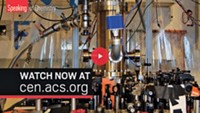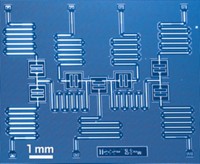Advertisement
Grab your lab coat. Let's get started
Welcome!
Welcome!
Create an account below to get 6 C&EN articles per month, receive newsletters and more - all free.
It seems this is your first time logging in online. Please enter the following information to continue.
As an ACS member you automatically get access to this site. All we need is few more details to create your reading experience.
Not you? Sign in with a different account.
Not you? Sign in with a different account.
ERROR 1
ERROR 1
ERROR 2
ERROR 2
ERROR 2
ERROR 2
ERROR 2
Password and Confirm password must match.
If you have an ACS member number, please enter it here so we can link this account to your membership. (optional)
ERROR 2
ACS values your privacy. By submitting your information, you are gaining access to C&EN and subscribing to our weekly newsletter. We use the information you provide to make your reading experience better, and we will never sell your data to third party members.
Analytical Chemistry
From C&EN Archives: Computational Chemistry
by Mitch Jacoby
September 9, 2013
| A version of this story appeared in
Volume 91, Issue 36
COVER STORY
From C&EN Archives: Computational Chemistry
Perusing C&EN Archives is like strolling along the avenues of the history of chemistry. Jump to the beginning of Computer Lane and wind your way toward the present, and you’ll find that researchers’ aims in incorporating automated computations into chemistry haven’t changed much in decades. But their sense of what may be possible has changed dramatically.
The New Equipment section of a 1948 issue of C&EN described an office-sized electric mechanical computer that was designed with a modern-sounding goal: to enable “mathematical explorations into fields of scientific analysis that have been formerly economically infeasible.” And in 1952, Pittcon attendees learned that a mass spectrometer hooked up to an electronic digital computer could complete an analysis of a 20-component hydrocarbon mixture in 10 minutes. The instrument even typed out the results on a paper tape.
By 1956, C&EN was reporting that high-speed computers would eventually make possible “calculations which could not heretofore be attempted.” Such calculations, discussed at a quantum chemistry conference, might be useful in predicting carcinogenicity and other properties of compounds not yet synthesized.
Continue strolling through the 1960s and onward, and the bits of computer news quickly begin to sound more modern. “Computations Aid Oligonucleotide Analyses,” a 1961 headline proclaims, while stories from the 1970s extol the virtues of computer-based chemistry education and national computation centers.
Just a few years later, computer aficionados expressed high expectations for computer-based molecular design. As one researcher put it in 1979: “You take the advances in our ability to describe and understand molecular interactions, couple [those] with the electronics industry’s ability to give us computational tools—which is already beyond our expectations of 10 years ago—and in the future—I hope within my lifetime—all we’ll really need to do is decide on the ultimate physical or biological response we want from a molecule, and the computer will design it.”
MORE ON THIS STORY
Introduction: Nine For Ninety | PDF
Chemical Connections | PDF
Antibacterial Boom And Bust | PDF
Small Science, Big Future | PDF
Understanding The Workings Of Life | PDF
Chemistry By The Numbers | PDF
Plastic Planet | PDF
The Catalysis Chronicles | PDF
Giving Chemists A Helping Hand | PDF
It's Not Easy Being Green | PDF
Readers' Favorite Stories | PDF
Nine Decades Of The Central Science | PDF
How Chemistry Changed the World | C&EN's 90th Anniversary Poster Timeline
Trying To Explain A Bond
A Toast To C&EN At 90




Join the conversation
Contact the reporter
Submit a Letter to the Editor for publication
Engage with us on Twitter